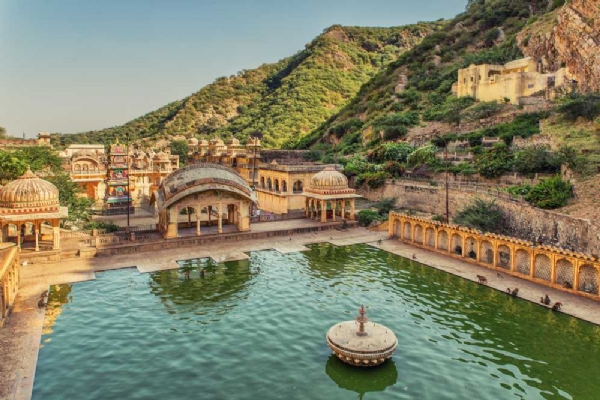Galta Ji temple: the historical glory of Rajasthan
Emperor Akbar too, visited Galta Ji to seek blessings, and donated 2592 bighas of land to the head of the temple after his wishes were answered
Total Views |
Rajasthan is without a doubt, one of the most scenic places in India, and also where people are bound to come across prominent places of worship. Today, we will explore one such temple, which doesn’t just have great religious importance, but also is one of the most aesthetics places here. The history buffs too, are in for a treat as the temple site has immense historical importance, visited by the likes of Emporer Akbar himself, to seek blessings. Regarded as an important sacred pilgrimage, the Galta Ji Temple is located 10 kilometres east of Jaipur. The temple complex is a cluster of many temples, and Galta Ji being the main one. The temples are built in a crevice of a mountain pass in the Aravalli hills.

The Galta Ji Temple was built by Diwan Rao Kriparam, an attendant at the court of Maharaja Sawai Jai Singh II. The temple complex was built in the 18th Century. Prior to building the temple, the place still used to be important to Vaishavites Ramanandis. Historians have said that before the 16th Century, many yogis and sadhus lived here at the site where Galta Ji Temple currently stands. The yogis, saints were driven away by the mystical powers of a Ramanandi Sadhu by the name Krishnadas Payo Hari. As time went by, the site became a centre of significant importance for both Ramanandi Hindus and Naga Sadhus.
One of the Most Visiting mandir and main tourist destinations in Rajasthan located in the hills of Aravalli !!
— Desi Thug (@desi_thug1) January 15, 2022
Can you Guess the Name and Location ? pic.twitter.com/btwHhUzpOW
Another important historical aspect of Galta Ji is that the founding philosophy of the ‘International ISKCON Movement’ started by Swami Prabhupada, was borrowed from ‘Govind Bhashya’ written by Swami Baldeo Vidyabhusan in Galta Ji. The Govind Bhashya is a note on Vedanta Sutra and was written in 1718 AD.
Moreover, Mughal Emperor Akbar too, visited Galta Ji to seek blessings, and donated 2592 bighas of land to the head of Galta Ji, after his wishes were answered to. This grant is a historical document that is still preserved at Galta Peeth. The Galta temples were submerged in water during the floods in Jaipur in 1981. However, the fast restoration work was able to bring the temples back to their glory soon after.
Architecture - The architecture of the Galta Ji is a mix of Indian classical and Rajasthani elements as there are beautiful frescoes to Indian mythology paintings along with canopies / curvilinear chhatris decorating the roofs of the temples. The windows are designed in typical Rajasthani architecture. The entire temple is built of pink sandstone having pavilions with intricately carved pillars and painted ceilings and walls.
Of all temples in the Galta Ji complex, Shri Gyan Gopal Ji temple and Shri Sitaram Ji temple are constructed in haveli style. The Shri Sitaram Ji Temple is the biggest among all temples at Galta Ji. The Hanuman temple in the complex is famous for its ‘Akahnd Jyoti’ (the eternal lamp), the flame of which has been burning for centuries, since the time the Hanuman idol was consecrated.
The temple complex has several sacred tanks or Kunds, used by pilgrims for bathing and washing away their sins. Galta Kund is considered to be the holiest of all kunds here, and also holds great significance as it is believed to have never dried up till date.
Also Read | Palitana – World’s largest temple complex
Legend - Galva Ashram is named after the famous sage, the Holy Saint Galav, paying tribute to his devotion. The legend of the temple dates back to prehistoric ages of Satyuga. It is related to Saint Galav, who lived at the site, spending thousands of years in penance through meditation, seeking the truth. It is believed that, pleased by the meditation of Saint Galav, the Gods themselves appeared before him, blessing the site with abundance of water, by bringing river Ganga here at Galta Ji, right from the Gaumukh (cow’s mouth).
If one is to believe the legends, the holy script of ‘Galvashram Mahatmaya’ says that during the Hindu month of ‘Kartik’, on a full moon day, which is also called as ‘Kartik Poornima’, the holy trinity, Brahma, Vishnu and Mahesh, visit the Galta Ji. Hence, taking a dip in the Galta Kund on this day provides the visitor with multi-fold blessings. If one is to visit the temple, it is advisable to beware of the monkeys, as they are present all around here!


